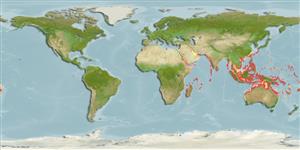Environment: milieu / climate zone / intervalo de profundidade / distribution range
Ecologia
marinhas associadas(os) a recifes; intervalo de profundidade 1 - 50 m (Ref. 11441), usually 1 - 15 m (Ref. 90102). Tropical; 30°N - 31°S, 30°E - 175°W
Indo-Pacific: Persian Gulf (Ref. 68964) and Red Sea south to Mozambique and east to Fiji, north to the Ryukyu and Bonin islands, south to New Caledonia. Recently recorded from Tonga (Ref. 53797).
Tamanho / Peso / Idade
Maturidade: Lm ? range ? - ? cm
Max length : 8.0 cm TL macho/indeterminado; (Ref. 2334); common length : 6.0 cm SL macho/indeterminado; (Ref. 37816)
Espinhos dorsais (total) : 8; Raios dorsais moles (total) : 9; Espinhos anais: 2; Raios anais moles: 8. Bluish silver in color, with 6 orange-yellow stripes, including a short post ocular stripe. Sub-equal along abdomen, and midlateral stripe ends into pinkish to orange spot on caudal fin base (red at night) (Ref. 48635). Greatest depth of body 2.7-3.0 in SL (Ref. 90102).
Body shape (shape guide): fusiform / normal; Cross section: compressed.
Inhabits sheltered clear water areas of lagoon and seaward reefs from depths of 1 to at least 49 m. Found in small or large aggregations under ledges, in holes, or even among long spines of sea urchins. Feeds on planktonic crustaceans and small invertebrates. Has been reared in captivity (Ref. 35404).
Mouthbrooders (Ref. 240). Distinct pairing during courtship and spawning (Ref. 205).
Masuda, H., K. Amaoka, C. Araga, T. Uyeno and T. Yoshino, 1984. The fishes of the Japanese Archipelago. Vol. 1. Tokai University Press, Tokyo, Japan. 437 p. (text). (Ref. 559)
Categoria na Lista Vermelha da IUCN (Ref. 130435: Version 2024-2)
Ameaça para o homem
Harmless
Utilização humana
Pescarias: espécies comerciais; Aquário: Espécies comerciais
Ferramentas
Relatórios especiais
Descarregue XML
Fontes da internet
Estimates based on models
Preferred temperature (Ref.
123201): 25 - 29.3, mean 28.4 °C (based on 3142 cells).
Phylogenetic diversity index (Ref.
82804): PD
50 = 0.5000 [Uniqueness, from 0.5 = low to 2.0 = high].
Bayesian length-weight: a=0.01318 (0.00802 - 0.02166), b=3.13 (2.99 - 3.27), in cm total length, based on LWR estimates for this species & (Sub)family-body (Ref.
93245).
Nível Trófico (Ref.
69278): 3.6 ±0.56 se; based on food items.
Resiliência (Ref.
120179): Elevada, tempo mínimo de duplicação da população menor que 15 meses (K=2.93).
Fishing Vulnerability (Ref.
59153): Low vulnerability (10 of 100).
🛈
Nutrients (Ref.
124155): Calcium = 221 [107, 630] mg/100g; Iron = 1.71 [0.80, 3.17] mg/100g; Protein = 19 [18, 20] %; Omega3 = 0.172 [0.067, 0.456] g/100g; Selenium = 57.9 [18.9, 160.0] μg/100g; VitaminA = 41.3 [9.2, 177.0] μg/100g; Zinc = 2.95 [1.65, 4.81] mg/100g (wet weight);
